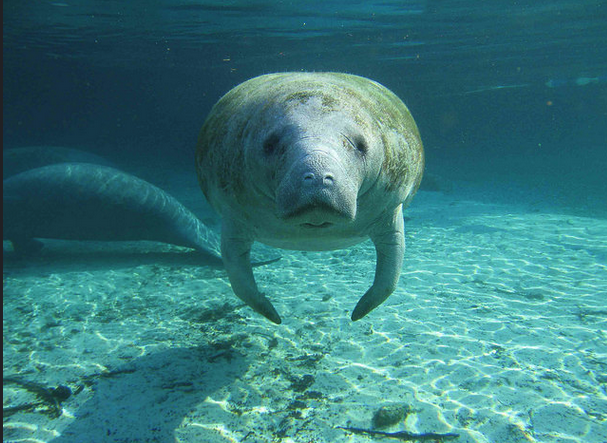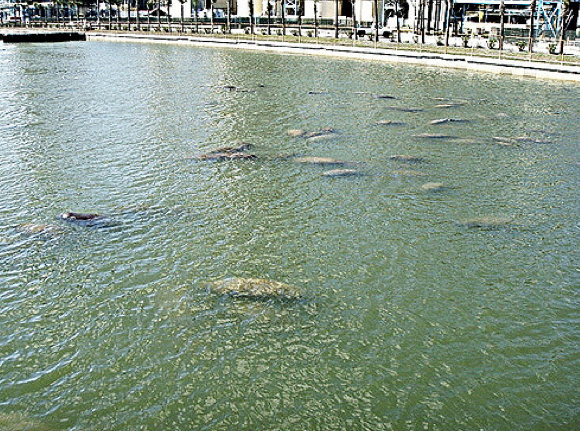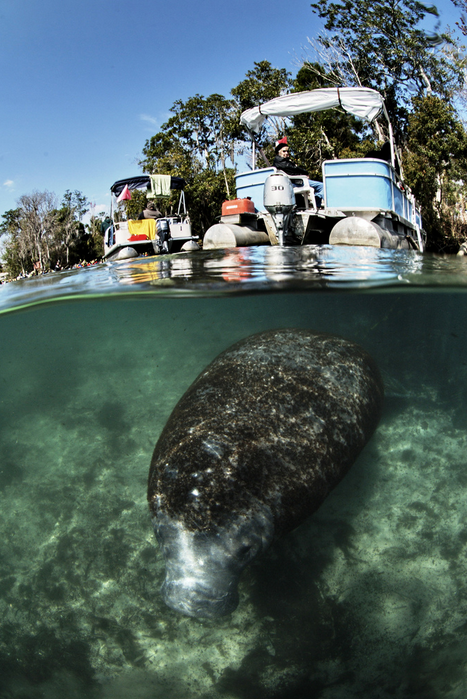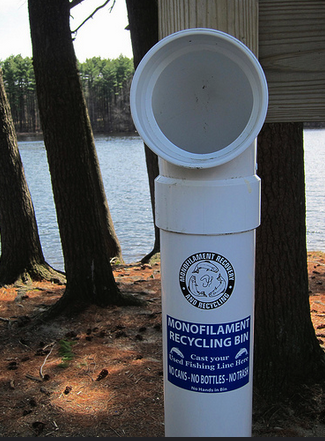Oh the Hu-manatee
“[T]he manatee is found in shallow slow moving rivers
the manatee is a migratory animal…
the manatee moves in estuaries moves in saltwater bays…
the manatee is completely herbivorous
the West Indian manatee has no natural enemies…
man with his boats and plastic and attitude…
the manatee has no natural enemies but unnatural man…
the manatee often drowns in canal locks of man…
the manatee dies in collision with water craft…
what steward of the earth is this unnatural man?
the manatee dies from litter and monofilament lines…
the manatee dies from loss of habitat claimed by man…
maimed by man, the manatee could be aided by man[.]”
“Manatee/Humanity”, a poem by Anne Waldman , accurately addresses the harmful effects that humanity has caused to populations of the West Indian Manatee. Specifically, in Waldman’s poem are shown a dark contrast between the advancement of the “unnatural man” and the downfall of the innocent manatee, which is currently an endangered species. The manatee is a foraging and herbivorous migratory animal that has no natural predators. Unknowing of the danger ahead, the manatee moves into warm waterways and will use these as refuge during cold temperature weather. Once the manatee gets there, a host of conservation issues in regards to the migratory and foraging behavior of the manatee becomes apparent. Manatee populations that engage in natural foraging and migratory behavior are being decimated by the “unnatural man“, as they fall victim to drowning in man made structures, watercraft accidents, and pollutants in the water. Because of these unfortunate circumstances, it is fair that the poet asks the following: “what steward of the earth is this unnatural man?” However, the poet also states that even though man has maimed the manatee populations, man could also potentially save the manatee populations through conservation efforts. In this blog post, I will attempt to describe the detrimental, multifaceted interaction that man is having on the West Indian manatee subspecies, the Florida manatee, conservation in regards to their migratory and foraging behavior, but also how man is now taking steps to aid in its conservation.
U.S. Geological Survey. “Here’s Looking at You Kid – Meet a Florida Manatee.” Photograph. flickr.com/photos. 2007. 30 Mar 2016. https://www.flickr.com/photos/usgeologicalsurvey/14530696570/in/photolist-o92BRd-ei4DSR-85HDJm-DnAf6g-6bij5K-CR8Qy6-JNjKu-wSd5bL-wwJAAd-wwGNbv-xc33Zi-y7Pb1e-xbVzqm-oumKSG-sLY2rY-vuDd9h-w9j8A1.
The natural response of the Florida manatee to temperatures that will lead to cold stress is to migrate to warmer waters. Incidentally, this behavior limits its ability to survive, and ultimately, its conservation in environments influenced by humans. Cold stress results in the impairment of immune response. Typically, the Florida manatee will migrate to warm-water refuges when confronted with cold winter temperatures of 18–20°C for long periods of time, or 10–12°C for shorter periods of time in order to avoid cold stress conditions. Because of this, approximately 60% of all Florida manatees will migrate to power plant outfalls that will be warmer in temperature (greater than 22°C). An additional 15% of Florida manatees will migrate to natural warm-water springs, or passive thermal basins when confronted with cold stress temperatures. These thermal refuges can be heated by solar radiation, ground water seeping, or the degradation of the benthic layer organic materials. Firstly, the outflow near the power plants may be particularly dangerous, as one common cause of Florida manatee death is becoming trapped in the water-controls of the plants by swimming too close, and subsequently drowning. In addition to potentially drowning from power plant structures, many manatees have also become reliant upon the use of the outflows as a warm-water refuge. Manatees will aggregate at these power plants because as a calf it will learn from its mother which thermal refuges to use. Potential problems with long-term conservation of the Florida manatees arise when these power plants close down due to outdated technology and high operation costs. Then, cold stress related deaths of the manatees that aggregate at the closed power plant will ensue, as manatees will stay near a familiar refuge site, even if is not operational. While it appears that the migration of the Florida manatees is affecting their conservation, foraging behavior appears to be as well.
amanderson2. “Lots of Manatees that turn up at the Power Plant in Apollo Beach.” Photograph. flickr.com/photos. 2010. 30 Mar 2016. https://www.flickr.com/photos/amanderson/4421334328.
The foraging behaviors of the Florida manatee also appear to have caused a detriment in their conservation when confronted with the “unnatural man”, as seen in the effects of motorboat collision and water pollution. Florida manatees will forage at depths of approximately 2.0 m in slow moving fresh water channels, or shallow coastal waters on Halodule wrightii and Syringodium filiforme seagrasses. Firstly, because the Florida manatee lacks natural predators, the presence of humans and motorboats in the water will not bother the manatee as it swims near the surface as it forages. As a result, the manatee does not always move out of the way of an approaching boat. Thus, the manatee will collide with the boat, or its propeller, which may lead to immense injury, or fatality of the manatee. These fatalities make up approximately 30% of all manatee deaths. And second, the industrialization of society has lead to the introduction of a vast array of major microfilament, plastic, and chemical pollutants that appear in waterways and may be ingested by the manatees when foraging for seagrass. By ingesting the plastics and microfilament, the manatees are subject to death by debris digestion. Additionally, by ingesting chemical pollutants such as aquatic herbicides containing copper, the bioaccumulation of copper in the liver of manatees has been seen to occur followed by subsequent toxic effects and death. With the introduction of the “unnatural man”, it appears that the foraging behavior of the Florida manatee is ironically working against its own survival; however, could man aid the manatee that has been maimed by man?
David Hinkel, and U.S. Fish and Wildlife Service Headquarters. “Endangered Florida manatee (Trichechus manatus) (7636818072).jpg.” Photograph. commons.wikimedia.org. 2005. 28 Mar 2016. https://commons.wikimedia.org/wiki/File:Endangered_Florida_manatee_%28Trichechus_manatus%29_%287636818072%29.jpg.
Though man has maimed the manatee in the past, it is possible for man to help in the conservation of Florida manatees in regards to their migratory and foraging behaviors in the future. Because the Florida manatee actively seeks warm waters when confronted with adverse cold conditions, the manatee will readily migrate to warm water outflows that are produced by power plants. This resource may lead to the short run mortalities of a few manatees due to accidental drowning, or the long run mortality of many manatees by halting the operation of these plants. Therefore, the implementation of alternative non-industry-dependent thermal refuges has been established in the same sites to maintain manatee populations through the use of solar-powered heating in these sites. Coupled with the use of industry-dependent thermal refuges, the restrictions and heavy fines to boaters found boating in designated manatee thermal refuge sanctuaries has lead to a curtailing in motorboat collisions with foraging manatees. Furthermore, by educating boaters on the effects of water pollution, programs such as the monofilament recycling program have lead to a decrease in pollution-based fatalities of the Florida manatee. It appears that the “unnatural man” could be a passable steward after all.
C.C. Chapman. “Fishing Line Recycle Tube.” Photograph. flickr.com/photos. 2010. 27 Mar 2016. https://www.flickr.com/photos/cc_chapman/4517142995/in/photolist-7TaxeM-6tHfT3-asYHup-k6A4BV-aycTat-6tDhBM-bQBEPa-6tHfSJ-6tHfSU-ax4qpq-6dsALQ-9qUqKS-9qqt17-6tH4bw-nNDpDp-6tCVMk-aEXjJs-6tGYum-idmjQT-nNDqwW-ax1HHt-5py8yD-6tH4GW-6tH5vC-6tCWkx-6tDhp6-6tCWBg-6tHfT7-9qRs1z-5pCqws-9qRsbv-6tGYtN-6tGYub-hdChx-6tGYtJ-6tGYtY-4Qf1mP-5JaECs-87jd25-8Gi5Vc-aRaYgK-pBucYK-jGBhRz-7WGtHW-yUF4Ei-pjZXbH-7M6mn1-pBd5Ck-fJc4AT-bsdzj1.
The Florida manatee is a gentle, herbivorous animal, which is currently endangered due to the detrimental relationship between its conservation and its migratory and foraging behaviors. This can be seen in the migratory behavior by the manatee’s propensity to migrate to and solely use warm water outflows of power plants, which will inevitably close. The foraging behavior of the manatees to stay close to the surface of the water as they forage on a diet of only seagrasses, causes them to be susceptible to motorboat collisions and to unknowingly ingest plastics or other chemical pollutants that are nestled in the seagrass. For these reasons, it can be surmised that the conservation of the manatees is hindered due to these behaviors in areas frequented by humans. However, through human efforts such as the creation of alternative non-industry-dependent thermal refuge sites, heavy fines and restricted access to manatee sanctuaries, and pro-environmental programs such as the monofilament recycling program, it appears that the conservation of the Florida manatee is possible. I hope that this blog post about the human caused issues of the conservation of the Florida manatee in relation to its foraging and migratory behavior has been enjoyable and enlightening, but that you are also aware that as educated citizens, we may work together to halt the endangerment of the Florida manatee.





Recent Comments